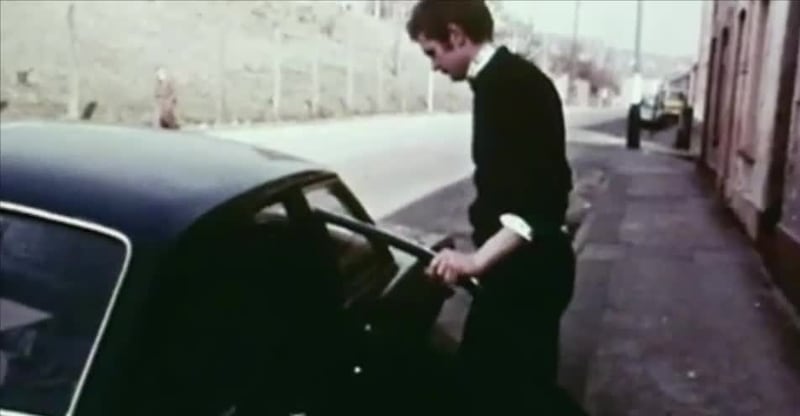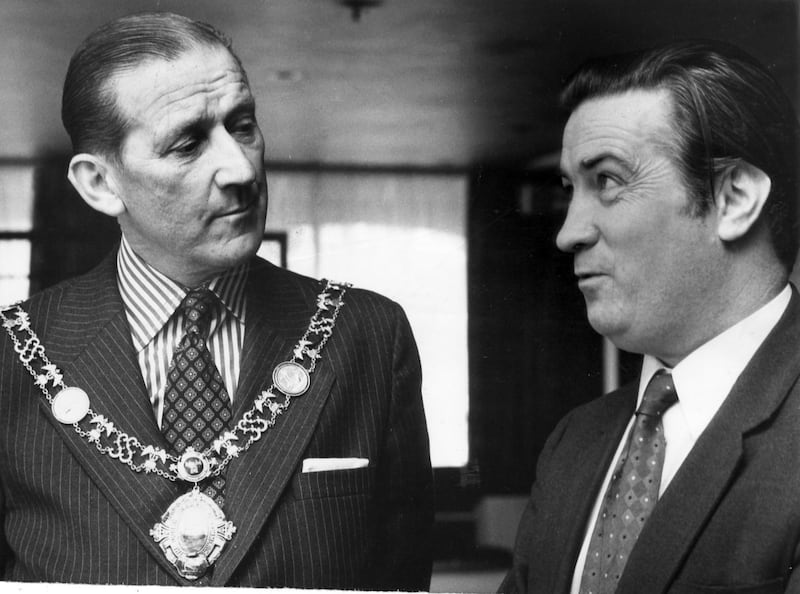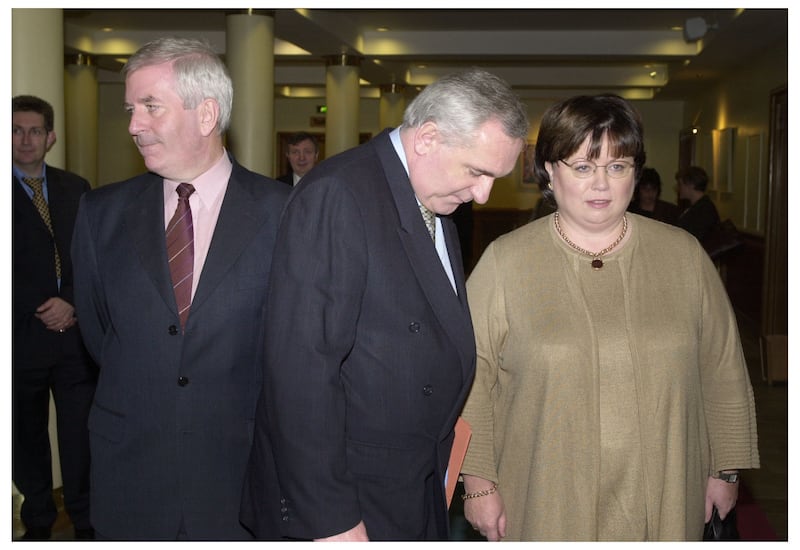Ireland joined the EEC, as it then was, in January 1973. This is one of a series of articles exploring our evolving relationship with the European Union – and its past, present and future
On New Year’s Day 1973, Aer Lingus ran a full-page ad on page three of The Irish Times, with the slogan “The Common Market is a bit Irish!” It added the explanation that “And so it should be. Because Ireland is very much a part of the new Europe.”
The image that dominates the ad is a cartoon map of western Europe. Ireland is inhabited by a Celtic cross, a thatched cottage and a few tourists (all men) fishing, golfing and driving an old-style Traveller’s caravan.
Europe is infested with miniature Paddies, again all male. One is serving pints of Guinness to beret-clad Frenchmen. One is trying, without success, to control a huge Irish wolfhound that is chasing an unfortunate Belgian. One is trading an Irish fish for a string of German sausages. One is being amazed by some French couture while a stout fräulein nearby tries on an Aran jumper.
Ireland’s house prices, earnings and favourite cars, from the 1970s to today in six charts
Ireland is one of the EU’s most successful case studies
Irish people struggling with energy crisis costs more than others in EU
Ireland enters top 10 of countries seen as having least public corruption, index suggests
There are no saints or scholars, no James Joyce or Eileen Grey or Samuel Beckett.
There are just two images – both improbable – that might be regarded as vaguely “modern”: a very unlikely “O’Brien Steelworks” in the Ruhr Valley and a stupid Irish crane-driver straightening the leaning tower of Pisa. They manage to seem even more ludicrous than all the rest.
Amid the lame attempts at humour and the intended celebration of Ireland’s entry that day into the European Community, the ad prompts a rather grim question: is this really all we Irish have to bring to the ‘new Europe’ – thatched cottages, Celtic crosses, Aran jumpers, wolfhounds, fish and maybe the odd cackhanded crane-driver?
For such a momentous moment, the mood that New Year’s Day was weirdly downbeat. The main Irish Times headline was almost comically anticlimactic: “Ireland Enters E.E.C. Without Any Fanfares”. Was there a competition among the subeditors to see who could come up with the most soporific passion-killer?
Our entry into what was now a club of nine rich western European nations was a sideshow for the EEC, an afterthought to the real action, which was the accession of the United Kingdom
There were no official ceremonies in Ireland. A few trees were planted by schoolchildren. The 160 babies born that day had little bronze medals posted to them by the Irish Council of the European Movement, with the date and the child’s name embossed on them. (Do any of them still exist?)
And that was about it. No fireworks, no gala concerts, no special programmes on RTÉ. Not even, in the spirit of the times, a votive Mass with a few hymns of thanks for the bliss of being alive to see this new dawn of Irish destiny.
In Brussels, meanwhile, all that happened was that an Irish official, Sean Keenan, handed a letter to an EEC official, André Dubois, and was given in turn a single glass of champagne. A slightly grudging spokesman explained that it was a bank holiday and that: “It is difficult to arrange something on January 1st when everyone is out skiing.” Monsieur Dubois presumably either drew the short straw or did not ski.
The lack of excitement in Brussels was more understandable than the apparent indifference in Ireland. Our entry into what was now a club of nine rich western European nations was a sideshow for the EEC, an afterthought to the real action, which was the accession of the United Kingdom.
It was freedom from Britain achieved by riding on Britain’s coattails. And it made Ireland, not just more European but more American
We were, in truth, no great catch. Our population was about the same as that of Paris. Our per capita GDP was less than two-thirds of the EEC average. Ireland’s total exports were worth little more than the equivalent of €1 billion, and the economy had a balance of trade of minus €340 million.
New foreign direct investment in Ireland in 1972 amounted to all of €16 million. Our financial contribution to the EEC in that first year of 1973 was 0.27 per cent of its budget.
There were, moreover, very good reasons to worry about the political stability of this territory that the EEC was acquiring. On the front page of The Irish Times that day, the boring news about entry into the EEC competes with a photograph of a ruggedly handsome young man in moody semi-profile.

His name is given as Martin McGuinness, his age 22. He had been arrested two days earlier in Ballybofey, Co Donegal, having abandoned a car in which there were 5,000 rounds of ammunition and 250 pounds of gelignite.
This is one small reminder that Ireland joined the EEC immediately after the bloodiest year in the history of the Troubles, one in which descent into all-out sectarian civil war did not seem at all an impossible fate for the island. Viewed from the mainland of western Europe, the importation of this turbulent place into what was, after all, a peace-building project, cannot have seemed altogether an occasion for joy.
The continuing ghastliness of the Troubles may help to account for the rather sombre public attitude to the beginning of Ireland’s great European adventure. But there was also a fierce complexity to this whole process, a string of knotty ambiguities that would take a long time to untie.
Ireland’s entry into the EEC was entangled in four apparent contradictions. It was a radically transformative project primarily supported by conservatives and opposed by progressives. It was a great vindication of Irish sovereignty that appeared in the guise of a voluntary transfer of sovereignty to the “ever closer union” envisaged by the EEC.
Fifty years earlier, Ireland had largely won political freedom from the UK. But in economic reality, it had remained utterly dependent on the British market
It was freedom from Britain achieved by riding on Britain’s coattails. And it made Ireland, not just more European but more American.
In 1973, Ireland had just about reached a stage where a majority of the population lived in towns and cities. Agriculture was still the backbone of the economy. Farmers were still by far the most powerful political lobby.
And it was farmers who gave their overwhelming support to Ireland’s membership of the EEC. This meant that the solid core of rural, conservative Catholic Ireland bought into modernity in the shape of headage payments and beef mountains.
If you want to know how Ireland managed a social revolution while keeping social tensions under control, consider all those bungalows and haciendas that began to sprout on dank Irish hillsides as the money from the Common Agricultural Policy (CAP) began to flow westwards. The revolution was televised – in TV lounges with shiny sofas and big picture windows.
Contrariwise, it was the leftish urban intellectuals who were most vehemently anti-EEC. Justin Keating, the brilliant and cosmopolitan Labour TD whose Into Europe series on RTÉ gave us a new catchphrase (“How’s things?” “Mighty – sure we’re Into Europe”) compared the EEC, during the 1972 referendum campaign, to “Hitler’s New Order”.

The Common Market Defence Campaign, which urged a No vote, had an impressive line-up of artists and intellectuals among its patrons: the great essayist Hubert Butler, the poet Austin Clarke, the 1916 Rising veteran and activist Máire Comerford, the playwright John B Keane, the novelist Monk Gibbon, the actor Siobhán McKenna, the lawyer and anti-apartheid campaigner Kader Asmal, the novelist and editor Peadar O’Donnell, Luke Kelly of The Dubliners and the academic sociologist and future president, Michael D Higgins.
They warned not just of “the depopulation of Ireland, the decline of our industry, the decimation of our farming population” but of “the eventual destruction of the Irish people as a viable distinct national community”.
Both sides turned out to be profoundly mistaken. The conservative farmers did not see how radically EEC membership would alter Ireland. The left-wing intellectuals did not see how it would make a “distinct national community” actually viable.
Secondly, Irish sovereignty was not diminished by being shared with the EEC. Arguably, it became truly meaningful. A seat at the European table as an equal of Germany and France – and indeed of Britain – made complete sense of Irish independence. Ireland was fulfilling the dream of generations of patriots: taking its place among the nations of Europe.
Third, joining the EEC can be seen as the second phase of the Irish independence struggle. Fifty years earlier, Ireland had largely won political freedom from the UK. But in economic reality, it had remained utterly dependent on the British market.
Without being in the EU, Ireland would never have become a major European hub for transatlantic investment
Even by 1973, well more than half of the total value of Irish exports went to the UK. Joining the EEC was the only way for Ireland to escape the gravitational pull of the British economy. Over the 50 years of membership, the UK’s share of Irish exports would drop from 55 per cent to 13 per cent.
The irony in this is that Ireland would never have been allowed into the EEC without Britain. Indeed, the terror for Irish governments and officials in the 1960s was precisely that Britain would join but that Ireland would be left outside, thus losing its main market across the Irish Sea without gaining new ones on the continent.
It was because they saw the Irish economy as a little appendage to the British that the EEC members let us in. Neither they nor we fully realised how membership would allow Ireland to complete its journey to independence.
(The British largely failed to understand this either. It was striking that, after the Brexit vote in 2016, so many of its supporters assumed that Ireland would simply have to leave the EU because it was still an economic satellite of its former ruler.)
Fourth, there is the paradox that being in Europe made Ireland much more profoundly American. Especially after the creation of the EU’s single market in 1993, Ireland’s position within it became increasingly attractive to US multinationals. Without being in the EU, Ireland would never have become a major European hub for transatlantic investment.

This meant, however, that a government minister, Mary Harney, could claim with some justification, in July 2000, that “Geographically we are closer to Berlin than Boston. Spiritually we are probably a lot closer to Boston than Berlin”.
There is indeed a sense in which EU membership contrarily consolidated Ireland’s cultural and psychological alignment with the Anglophone world, especially that part of it that spoke with an American accent. This identification also had a political dimension: the American ideology of “rugged individualism” was promoted more assiduously by Ireland’s dominant political elites than Europe’s more collectivist ethos.
It has been true, too, that not all of Ireland’s experiences of EU membership have been positive. The sacrificing of the fishing industry in the entry negotiations had bad consequences for Ireland’s potential to develop as a maritime nation. The wave of closures of older industries, unable to compete in the increasingly open European market, contributed to the misery of the 1980s.
The great marker of what the EU did for us is that we knew, in 2016, that we were able to stay in it even after the UK left
The flood of cheap money that washed in after the deregulation of EU financial markets helped to inflate the property bubble that burst so catastrophically in 2008. The wrong-headed reaction of the EU and the European Central Bank to the euro zone crisis made Ireland’s agony much deeper and more long-lasting than it ought to have been.
Yet the shock of Brexit in 2016 brought a sobering realisation that the balance of costs and benefits lies overwhelmingly on the benign side of the ledger. Being in the EU helped to stabilise Ireland in the most dangerous period of the Troubles, squeezed much of the misogyny out of official policy in Ireland, made Ireland attractive to many of the world’s leading companies, gave real substance to independence and helped Ireland to transform itself economically, socially and psychologically.
Brexit brought home to us the reality that, beyond a lunatic fringe, very few of us really wanted to retreat into self-pitying isolation and myths of exceptionalism. As we could have told our friends across the Irish Sea, we had seen that future and it didn’t work.
The great marker of what the EU did for us is that we knew, in 2016, that we were able to stay in it even after the UK left. We did not have to dance forever with those that brung us! We have other partners now.
Perhaps, in that knowledge, we can now return to the question implied by that Aer Lingus cartoon on the day we joined. If “Ireland is very much a part of the new Europe”, what do we bring to it?
















